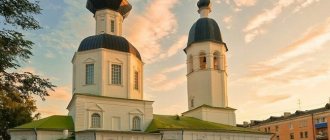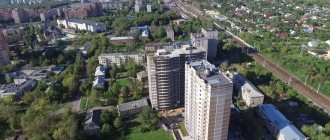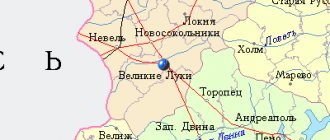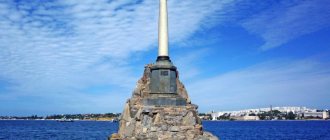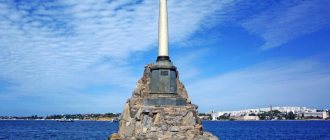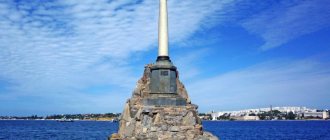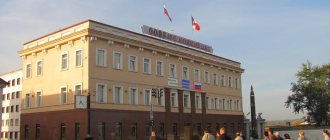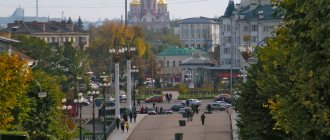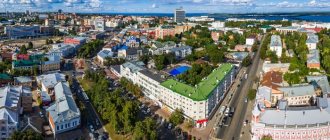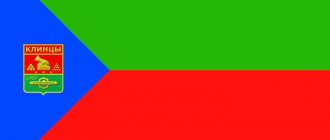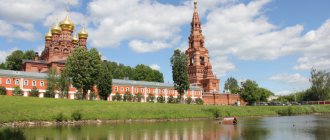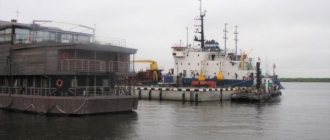On the banks of the beautiful Lovat River lies the small, historically rich and cozy city of Velikiye Luki. Since 1166, its history has been traced in chronicles. He remembers the great path “from the Varangians to the Greeks,” wars and destruction. The warrior city or shield city Velikiye Luki, due to its advantageous location, has always been a strategic and geopolitical object in the North-West of Russia.
The main attractions of the city and region are exhibitions dedicated to the Second World War, writers, poets, scientists and public figures. Also, every year in early June, the International Balloon Aeronautics Competition (https://balloon-cup.ru) is held in Velikiye Luki - a beautiful spectacle that attracts thousands of tourists from all over the world.
Velikiye Luki Fortress
The fortress acquired its final form only in the 18th century - before that it was constantly rebuilt. Thus, in August-September 1580, the troops of Stefan Batory attacked Velikiye Luki. The fortress was significantly destroyed, but in September of the same year, fortifications were erected according to the fortification plan of the conquering king.
During the Time of Troubles of the 17th century. centuries, the fortress was practically destroyed. By order of Peter I, in 1704, instead of dilapidated wooden buildings, a stone bastion-type fortress was erected, an exact copy of Peter and Paul Fortress. However, after the Battle of Poltava in 1709, the fortress lost its defensive purpose.
During the Second World War, the fortress regained its defensive status and became the site of the Velikiye Luki operation of 1941/43. From 1971 until today, the fortress has been a museum. Here you can see six bastions and a pair of arched gates. The walls attract with their height of 21.3 meters, and the towers with their 50-meter grandeur. The territory of the fortress is 11.8 hectares.
to the Tank Flying into the Sky was erected on the northwestern Engineering Bastion . It is recognized by many foreign and Russian tourists as the most beautiful tank monument in the world.
In the summer of 1941, stubborn fighting took place in Velikiye Luki. During the decisive assault on January 3, 1943, the KV-13 tank broke into the fortress, but was set on fire. The crew refused to surrender and headed into the fortress lake in a burning car.
To perpetuate the feat of the tank soldiers who fell outside the city, Marshal A.Kh. Babajanyan donated a T-34 tank to the city, which was timed to coincide with the 30th anniversary of the liberation of Velikiye Luki. The monument is located on a hill, as if preparing for takeoff, which is where its popular name came from.
On the northeastern bastion, at the highest point of the city, is the Obelisk of Glory . The 26-meter stone structure and the Neplyuev Bastion are reflected in the Lovat River. Velikolukskaya Fortress is currently used as an open-air museum, a place of recreation for citizens, and also as a launching pad for balloons.
Balloon Festival
At the mouth of the Lovat River there is a man-made island created by no one knows who or why. It is here that the annual international festival is held. For a whole week, the sky over the ancient city is decorated with colorful balloons. The grandiose holiday attracts all the townspeople and a large number of special guests.
To conduct the most spectacular and spectacular stage of the competition, a container is installed on the river into which the balloon pilots must hit it with a marker.
Park of Culture and Recreation
Address: Krasnoflotskaya embankment, 1 Telephone: 8 (81153) 3-63-11 Website: https://vk.com/club34452823 Opening hours: around the clock Cost: there are paid equipment rental services, attractions from 70 rubles.
Next to the fortress there is a park of culture and recreation - a place of recreation for citizens and guests of the city. In the southern part of the park, on the square of the same name, there is a monument to Alexander Matrosov , a hero of the Soviet Union, who covered the embrasure with his chest, which made it possible to successfully complete the operation to attack a strong point near the village of Chernushki. The Eternal Flame burns nearby on the Walk of Fame.
Two branches of the Lovat River go around the artificially built island of Dyatlinka , located east of the rampart. Currently, the Arena sports complex, various sports grounds and recreation areas are located on its territory. You can get to the island via a beautiful pedestrian suspension bridge.
The Lovat River itself is also noteworthy. In ancient times, the Volga trade route passed along it.
Temple in the name of St. Tikhon
The modern temple, which appeared in the city quite recently, in 2012, was built with donations from citizens and local entrepreneurs. It was consecrated in 2016 and perhaps soon this beautiful building will be called the Cathedral.
Velikoluksky Museum of Local Lore
Address: pl. Matrosova, 1 Phone: 8 (81153) 7-27-11 Website: https://www.vlmuzeum.ru/ Opening hours: Daily from 10.00 to 17.30, closed Mon. and the last Thursday of the month Cost: Full - 50 rubles, school, student, pension - 25 rubles, preferential categories of visitors - free. Last Wednesday of every month - free entry for all persons under 18 years of age
Not far from the park is the Local History Museum of Military Glory named after. A. Matrosov, where you can see personal belongings and photographs of the hero, as well as exhibitions about the Great Patriotic War.
The museum tells about the history and nature of the Pskov region. The museum's fund is supplemented by a collection of butterflies.
Velikoluksky Drama Theater
Address: ave. Oktyabrsky, 28/13 Telephone: 8 (81153) 3-09-01 – director; 8(81153) 3-84-40 (chief director) Website: https://lukidrama.ru/ Working hours: Tue-Sun: 09.00-21.00. Lunch: 13.00-14.00. Mon: closed
According to historical data, the Velikoluksky Drama Theater existed at the beginning of the 19th century, but at an early stage it was largely amateur. In 1919, a new stage in the development of the theater began; the first play on the professional stage was “At the Lower Depths” based on M. Gorky. Currently, the theater is experiencing a creative upsurge, the repertoire has been significantly updated. The theater troupe went on tour from 2002 to 2005 in the cities of the CIS.
Monument to Marshal of the Soviet Union K.K. Rokossovsky was installed on Teatralnaya Square near the Drama Theater. The commander spent most of his life in Velikiye Luki.
House-Museum of Academician I.M. Vinogradova
Address: st. Stavskogo, 48 Phone: 8 (81153) 7-38-36 Website: https://imv.vlmuzeum.ru/ Opening hours: 10:00 – 17:30 Tue-Sun, Closed on Monday. Sanitary day is the last Thursday of the month. Open Day – last Wednesday of the month (for persons under 18). In summer: 10:00 – 17:00 Tue-Sat Weekends – Sun, Mon; Sanitary day - the last Thursday of the month Cost: Entrance fee: adults - 60 rubles, schoolchildren, students, pensioners - 30 rubles, preschoolers - free. Carrying out the event: adults - 80 rubles, schoolchildren, preschoolers, students, pensioners - 70 rubles.
A unique museum in Russia dedicated to the mathematician. The museum's exposition is located in the scientist's parental home.
In 1982, Ivan Matveevich Vinogradov himself personally accurately conveyed the interior of all the rooms of his Moscow apartment. The exhibits of the museum are memorial items reflecting the hobbies of Ivan Matveyevich, various gifts for anniversaries and documents.
Economy
The volume of shipped goods of own production in manufacturing industries (2006) amounted to 7.51 billion rubles
Among these productions, the largest share belongs to:
- food production – 3.10 (billion rubles)
- production machinery and equipment – 1.28 (billion rubles)
- production of electrical equipment, electronic and optical equipment – 0.93 (RUB billion)
- production of metal products - 0.83 (RUB billion)
Literary and Art Museum of the History of the Great Patriotic War named after I. A. Vasiliev
Address: 182156, Pskov region, Velikoluksky district, p/o Borki Telephone: 8 (81153) 2-31-01 Website: https://www.museum.ru/M1948 Opening hours: Daily from 10.00 to 17.00, Weekends : Sunday Monday; excursion services on weekends by prior arrangement. Cost: Adult - 20 rubles, children - 10 rubles, students - 15 rubles. Excursion service: adults - 150 rubles, children - 100 rubles, students - 130 rubles. How to get there: from Velikie Luki by bus to Nevel, Vitebsk, Opukhliki to the “Sovkhoz Borki” stop. From Nevel by bus to Velikiye Luki.
Located in Velikoluksky district, in the village of Borki. Founded on the initiative of WWII veteran I.A. Vasiliev in 1988. The museum is located in a picturesque place in a pine forest near the lake.
The exhibition consists of a huge collection of books, newspapers, autographs and various materials dedicated to front-line writers and artists. Every year the village hosts a festival of front-line poetry, which attracts poets from all over the country.
As part of the museum complex there is a house of Environmental Education, also founded by Ivan Afanasyevich.
Museum-Estate of Sofia Kovalevskaya
Address: Pskov region, Velikoluksky district, Polibino village Telephone: 8 (81153)2-95-23; 8-911-355-64-62 E-mail: Opening hours: Every day from 10.00 to 17.00 Weekends - Saturday and Sunday. Excursions upon prior request are accepted on any day of the week. Cost: 30 rub. — schoolchildren, pensioners, students, 40 rubles. - adults. Video shooting - 250 rub. Excursion services: adults - 300 - 600 rubles, students - 550 rubles, schoolchildren, pensioners - 500 rubles. How to get there: From Velikiye Luki - by bus "Velikiye Luki - Nevel" From Pskov by bus "Pskov - Velikiye Luki" (stop "Polibino").
Initially, the estate was part of the estate of I. I. Mikhelson; in 1824, Sofia Vasilievna’s father bought it. The house was built in pseudo-Gothic style.
Sofia Kovalevskaya was the first female mathematician, public figure and writer, which is reflected in the museum’s exhibition. The collections on display consist of personal letters, photographs, handwritten versions of her novels and objects of applied art.
Museum-Estate of M. P. Mussorgsky
Address: Pskov region, Kunyinsky district, p/o Naumovo Telephone: 8 (81149) 3-11-40 Website: www.museum.ru/M1951 Opening hours: Every day from 9.00 to 17.00, except Mondays. Excursion service by prior arrangement. Cost: Full - 60 rubles, children - 20 rubles, pensioners - 20 rubles, students - 40 rubles. Foreign citizens: full - 120 rubles, children - 80 rubles. How to get there: From Moscow - by train "Moscow - V.Luki" to the station. Žižica (2 km from the museum). From Velikiye Luki by train “V. Luki - Moscow”, “V. Luki - Nelidovo” to the station. Zhizhitsa, by car: Moscow-Baltic highway (400 km), there is a sign “Museum of M.P. Mussorgsky"
60 km from Velikiye Luki there is another attraction that many tourists and guests of the city strive to visit. This is the estate of the great Russian composer M.P. Mussorgsky. The museum-reserve is the only museum of the Russian composer in the world.
The estate, located on the shores of Lake Zizhitsky, is the family nest of Modest Petrovich’s ancestors on his mother’s side. The museum's exhibitions are located in four buildings; they represent the life and work of the composer, his production of operas, as well as the life of 19th-century peasants and a winter garden.
Chapel of Alexander Nevsky
The small white chapel on the shore of Lovat amazes with its modesty and snow-white purity. The chapel was erected in 1884, in memory of the suddenly deceased Russian Tsar Alexander II.
Inside there is always an image of the Great Alexander Nevsky.
Museum of Postal Communications of the Pskov Region
Address: st. Nekrasova, 1 Phone: 8 8 (81153) 5-63-33, 5-75-55 Website: https://www.russianpost.ru/rp/company/ru/home/museum/fgup/pskov Opening hours : daily from 10.00 to 16.00, service for excursion groups upon prior request, including Saturday and Sunday. Cost: Adult – 60 rubles, school, student – 30 rubles, preschool – free.
The Velikiy Luki Museum is housed in three halls, where the first is a stylized Yamsk hut, decorated according to the custom of that time and the life of postal workers. The second hall of the museum offers you to get acquainted with collections of postcards, stamps, and postcards from different times. The third is an exhibition dedicated to postal paraphernalia, it presents banknotes, postal scales and a lantern, as well as a working gramophone.
The museum also displays a collection dedicated to International Aeronautics Meetings.
Cathedrals and architectural monuments
The war caused irreparable damage to the city, and there are practically no architectural monuments left here. The main part of the buildings are buildings in the Stalinist Empire style.
Church of the Kazan Icon of the Mother of God
Address: Pushkinskaya st., 2 Telephone: Website: https://luki-eparhia.ru/index.html Opening hours: Daily: 08.00-19.00. Lunch: 12.00-13.00
Built in 1821 in Baroque style. The appearance of the church has not undergone any changes. The bell tower still delights parishioners today. The church has fully preserved the iconostasis. Of the three altars - the Apostles Peter and Paul, All Saints, and the Kazan Mother of God - only the last two have survived.
The church is located in an ancient cemetery dating back to 1803, which is the burial place of famous people of the city, for example, Lieutenant General Tyrtov, nun Palladia, and merchant Chudov.
Holy Ascension Cathedral
Address: Uritskogo st., 4. st. K. Liebknechta, 5 - parish Telephone: 8 (81153) 3-63-39 Website: https://luki-eparhia.ru/index.html Opening hours: Daily: 08.00-19.00. Lunch: 12.00-13.00
Built on the site of the Ilyinsky Monastery, which was burned during the Time of Troubles. The church, rebuilt in the Baroque style in the 18th century, was called Peter and Paul and belonged to the Ascension Convent.
In Soviet times, the temple was brought into a “non-cult form” and only at the end of the 20th century was it restored and re-consecrated.
Particularly significant shrines and relics:
- Icon "Joy of All Who Sorrow"
- Icon of St. Tikhon
- Icon of St. Martyria of Zelenetsky
- Particles of saints' relics
Remains of the foundation of the Catholic Church of St. Anthony of Padua and the Name of the Venerable Virgin Mary
Address: Parkovaya st.
In 1904, after much petition and construction, the Catholic Church in Velikiye Luki was consecrated and opened its doors. In 1928, the temple community transferred the spiritual building to the city club.
The damaged church was dismantled into bricks after the liberation of the city in 1943. Today, the foundation, basement and some fragments of the walls have been preserved.
Kazan Church
Perhaps the only church in the city that did not stop its services for a single day, even in Soviet times. That is why it is best preserved both inside and outside. Built in 1821 not far from the city cemetery, where until the 60th century the most worthy citizens were buried.
